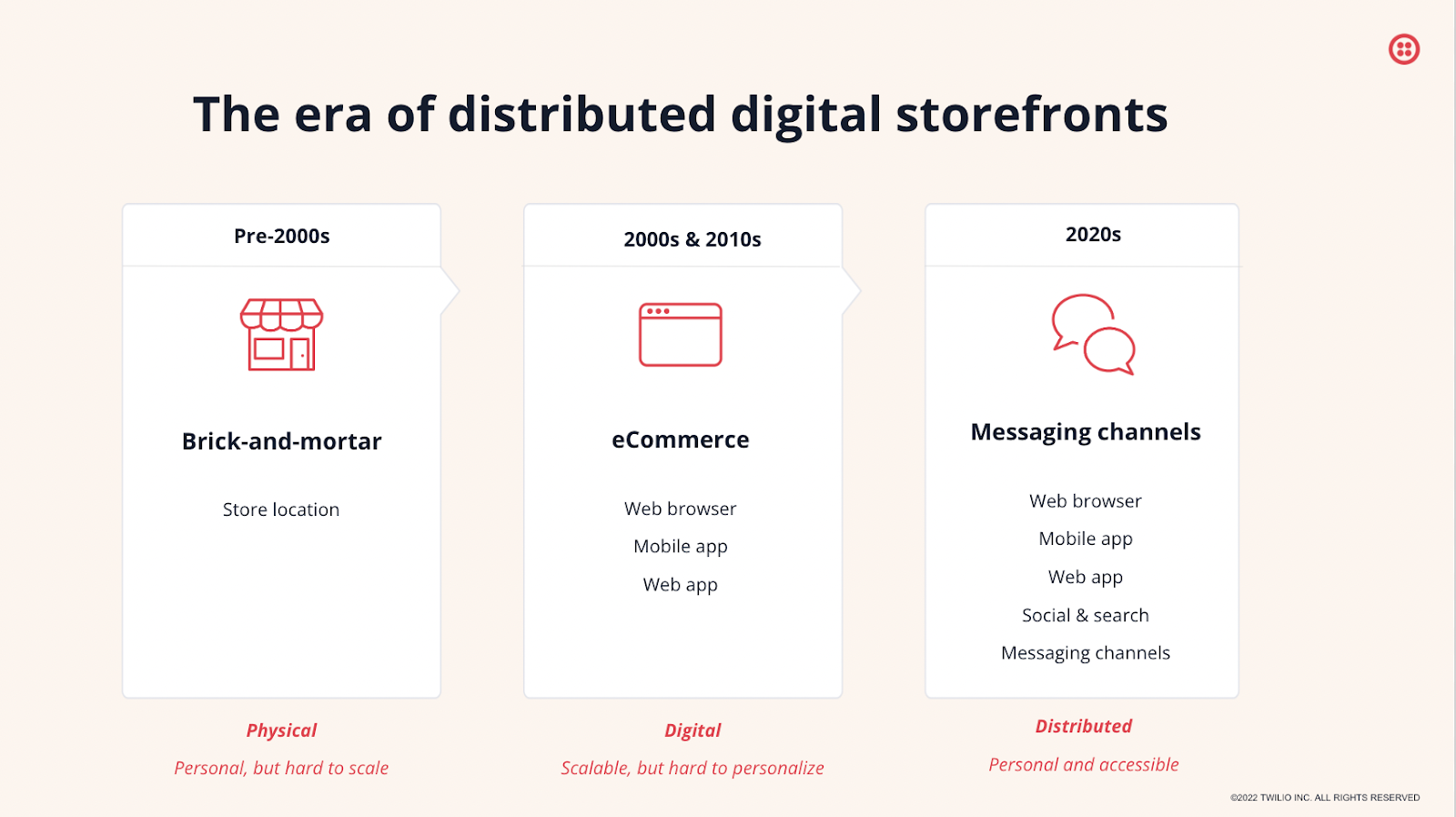How Conversational Messaging Powers Distributed Digital Storefronts
Time to read: 3 minutes

Historically, businesses have expected consumers to visit their physical locations or websites to make purchases and get support. But that’s quickly changing. Now, customers want more control over these conversations. They’re tired of being spoken at with one-sided communication. Instead, consumers now expect brands to speak with them.
By limiting interaction with customers to traditional channels, businesses put the responsibility squarely on customers’ shoulders. That means they have to do more work—physically going to the store’s location or visiting the website. By doing this, businesses miss out on important opportunities to connect with their customers on the channels they prefer.
The solution is conversational messaging. By showing up in the channels consumers’ prefer, businesses can build distributed digital storefronts that open up new revenue opportunities and create more meaningful opportunities for engagement.
We wanted to learn more about this trend, so we surveyed nearly 4,000 consumers across 10 countries and compiled all our insights into a new report. Here's the TLDR on what you need to know. Be sure to download the full version for more insights.
What is a distributed digital storefront?
A distributed digital storefront is an opportunity to meet customers where they already spend their time. Instead of expending time and resources trying to entice them to come to your brick and mortar store or website, distributed digital storefronts let you identify the channels consumers prefer and connect there.

It also means starting and completing an interaction solely through these channels—through conversational messaging—instead of leading customers back to your website.
This is exactly what customers want, according to our survey. In fact, 80% of consumers say they’d like brands to offer conversational messaging. And 74% say conversational messaging simplifies the purchasing process. Conversational messaging makes it easier for customers to find the answers they need and even make purchases, all from the channels they prefer. And as a business, you’re improving and accelerating their customer journey.
How to interact with customers via a distributed storefront
Our survey showed 77% of consumers want to use conversational messaging to get help with selecting a product or service. And 58% would use messaging channels to purchase a product or service if they had the option. This is, in part, because consumers prefer 1:1 support. And personalization is a huge part of that.
In order to personalize interactions over messaging, brands must invest in collecting zero- and first-party data. This information, provided by customers themselves, will help you understand what matters to them most—their pain points, their interests, their communication habits, etc. Saving this information and building rich customer profiles enables businesses to cut through all the generic noise constantly thrown at consumers and, instead, build trust with them.
As for the channels, those include SMS, in-app chat, web chat, WhatsApp, and Facebook Messenger. You can find a full breakdown of channels by regional preference in the full report.
Conversational messaging brings convenience to the customer experience by allowing consumers to shop or get help from exactly where they are. For example, a potential customer on Facebook sees a targeted advertisement for a bicycle. Rather than having to visit the website, the customer can chat with an expert about their bicycle needs right there. They can start, and even complete, a purchase without ever having to leave Instagram.
As another example, a potential customer opted in for SMS communication with a contact lens company. Because the business collected data from this customer (with permission), it knows when it’s time for their next purchase and can contact them through SMS for easy ordering. Instead of leading customers to the website, conversational messaging enables them to ask any questions and make the purchase solely through texting.
Why distributed digital storefronts are the future of customer engagement
Between marketing efforts like push notifications, promotional emails, and display ads, consumers are constantly being talked at. These traditional tactics leave them feeling frustrated, especially when they’re not personalized, and even encourage them to put up blinders to business’ outreach.
“[Customers] actually just care, number one, if they try to talk to you, are you there listening? And number two, is it a coherent conversation? Is it completely destroyed across a bunch of different phone numbers and shortcodes, all sorts of software, or does it make sense?" — Jeff Lawson, CEO of Twilio
But distributed digital storefronts open up these conversations and ensure communication goes both ways. It makes customers feel heard and builds trust with them. In fact, 95% say they would trust a brand more if it was easy for them to initiate a conversation. With conversational messaging through distributed digital storefronts, you are meeting your customers where they prefer, how they prefer. It’s the future of customer experiences that consumers want.
Meet customers in their moment of need with distributed digital storefronts
Trying to guide customers back to your website to make purchases and get help is a thing of the past. With distributed digital storefronts, you take the onus off the customer and instead offer them targeted, personalized communication that’ll guide the buyer through their journey the way they prefer.

Related Posts
Related Resources
Twilio Docs
From APIs to SDKs to sample apps
API reference documentation, SDKs, helper libraries, quickstarts, and tutorials for your language and platform.
Resource Center
The latest ebooks, industry reports, and webinars
Learn from customer engagement experts to improve your own communication.
Ahoy
Twilio's developer community hub
Best practices, code samples, and inspiration to build communications and digital engagement experiences.


